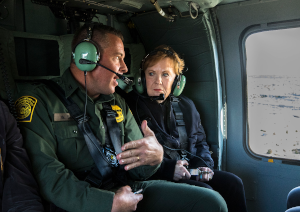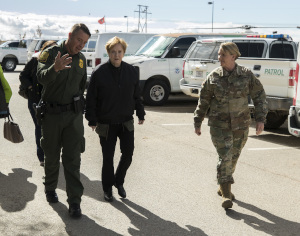Story by Texas Military Department Public Affairs Office
EL PASO, Texas- Members of the Texas Military Department hosted a congressional visit to the El Paso area of the Texas-Mexico border on November 22, 2019. There, Congresswoman Kay Granger (TX-12) met with the Adjutant General of Texas, Maj. Gen. Tracy R. Norris, and received an overview of the Joint Task Force Guardian Support mission, currently led by the United States Customs and Border Protection (CBP). Congresswoman Granger also visited with troops currently assigned to Joint Task Force Guardian Support.
The Texas Army National Guard began their partnership with CBP beginning in 1989, with the start of the Texas Joint Counter Drug Task Force. Throughout the years, Texas Soldiers and Airmen have operated in support roles to enhance border security. A 30 year mission of continuous sustainment has evolved from the control of drug infiltration to the United States, to logistical and intelligence operations along the southwest border.
Currently, Joint Task Force Guardian Support is comprised of Soldiers and Airmen from more than 12 states. Their mission is to operate in a supportive role which allows CBP agents to return back to enforcement duties and the administration of immigration law. Operations performed by the National Guard include aerial support, motor vehicle maintenance, transportation, detection and intelligence analysis and logistical support, among other capabilities.
 EL PASO, Texas -- U.S. Border Patrol Agent in Charge Walter Slosar gives a guided aerial tour of the U.S. border to Rep. Kay Granger, the congresswoman from Texas District 12 and ranking member of the House Appropriations Committee, and the Adjutant General of Texas, Maj. Gen. Tracy Norris, during her congressional visit to the area, Nov. 22, 2019. The delegation traveled by a Texas Army National Guard UH-60 Black Hawk from El Paso through Monuments I and III to the U.S. Border Patrol's Santa Teresa Station in Sunland Park, New Mexico. At the station, Rep. Granger, Maj. Gen. Norris, U.S. Army Budget Liaison Maj. Mark Bedrin, House Appropriations Committee Professional Staff Homeland Minority Clerk Dena Baron and Communications Director Sarah Flaim, met with CBP personnel and U.S. Army Corps of Engineers representatives to further discuss the state of the border, specifically in their sector. (U.S. Army National Guard photo by Spc.
EL PASO, Texas -- U.S. Border Patrol Agent in Charge Walter Slosar gives a guided aerial tour of the U.S. border to Rep. Kay Granger, the congresswoman from Texas District 12 and ranking member of the House Appropriations Committee, and the Adjutant General of Texas, Maj. Gen. Tracy Norris, during her congressional visit to the area, Nov. 22, 2019. The delegation traveled by a Texas Army National Guard UH-60 Black Hawk from El Paso through Monuments I and III to the U.S. Border Patrol's Santa Teresa Station in Sunland Park, New Mexico. At the station, Rep. Granger, Maj. Gen. Norris, U.S. Army Budget Liaison Maj. Mark Bedrin, House Appropriations Committee Professional Staff Homeland Minority Clerk Dena Baron and Communications Director Sarah Flaim, met with CBP personnel and U.S. Army Corps of Engineers representatives to further discuss the state of the border, specifically in their sector. (U.S. Army National Guard photo by Spc.
Christina Clardy)
The National Guard aerial support function has been vital to assisting federal agents in the field with monitoring migrants. The National Guard also assists with aerial rescues. Due to the continuous support of the National Guard, CBP has been able to enhance its security efforts along the southwest border. National Guard ground support is comprised of Soldiers and Airmen providing motor vehicle maintenance support, thus increasing the roadside capabilities within the CBP force. With the support of Congresswoman Granger, returning agents to enforcement duties has become a more obtainable goal for CBP.
Congresswoman Granger is no stranger to the Texas National Guard. Throughout her career, she has worked to prioritize federal funding for concurrent military modernization efforts in order to keep the National Guard at par with the active component. In 2017, as the Chairwoman of the House Appropriations Defense Subcommittee, Rep. Granger oversaw the appropriation of eight C-130J Super Hercules aircraft for the Air National Guard. This marked the first time that the National Guard had received new C-130J models since 2005.
“Modernized air assets provide a stronger future for aerial delivery support and make the unit more competitive for additional missions,” said Maj. Gen. Dawn Ferrell, Deputy Adjutant General for Air, Texas Military Department. “If the 136th Airlift Wing receives C-130J models, it will extend the unit's aircraft lifespan significantly over the current C-130H model. With its increased cargo capacity and improved performance characteristics, the C-130J would enhance the wing's operational capabilities to better serve Texas and the nation.”
Congresswoman Granger’s visit to the current border mission, Joint Task Force-Operation Guardian Support, was an opportunity to highlight her focus on domestic response strategy. It also allowed her to demonstrate her continuous bipartisan support of both the Guard and the citizens of Texas.
“Her support has ensured the UH-72 Lakota’s availability for domestic support missions, to include hurricane response, wildfire suppression and border operations,” said Brig. Gen. Thomas Suelzer, Director of Joint Staff, Texas Military Department.
As a voice for the National Guard, Ms. Granger was successful in the critical fight for maintaining AH-64 Apaches and Infantry Brigade Combat Teams within the National Guard, and has worked tirelessly to ensure the National Guard’s operational readiness is maintained. When force structure conversations take place between the Active Duty and the Guard, the Texas Delegation looks to her for her leadership in defense related issues. Ms. Granger has worked tirelessly to remain educated on the Guard issues that affect her district, the Texas Guard and the Guard’s 54 states and territories.

Even now, as the ranking member of the powerful House Appropriations committee, Ms. Granger continues to support the mission of the National Guard.
“The Congresswomen’s support of long-term sustainment of the RC-26B in the 2020 National Defense Authorization Act protects a manned platform at the 147th Attack Wing,” said Maj. Gen. Ferrell. “This airframe is an integral asset used domestically in support of the southwest border mission and is unique to the Guard.”
These improved capabilities within the Texas Military Department have amplified readiness levels, mirroring those of units on active duty. This allows Maj. Gen. Tracy R. Norris to heavily focus on the future of the organization and the growth of both manpower and resources for the Texas Army and Air National Guard.
“The Texas Military Department is extremely thankful for the ongoing support of the Texas Congressional delegation and the leadership provided by Congresswoman Granger,” said Marcy Weldin, Director of Government Affairs, Texas Military Department. “Because of her support we are better equipped to serve the citizens of Texas and the nation when called upon. For that reason, Maj. Gen. Norris has nominated her for the National Guard Association of the United States’ distinguished Harry S. Truman award.”
Congressman Granger’s other awards include the Minuteman Award, Navy Distinguished Public Service Award, as well as the Great American Patriot Award.